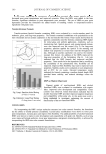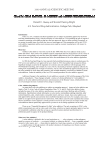BASIC OPTICS OF EFFECT MATERIALS 89 to have the phase of one wave shifted relative to the other. Figure 8 depicts a wave and a wave that is phase shifted by 0 degrees. The values of these two waves are added to give the wave that is the result of interference. It is important to note that the wavelength does not change as a result of interference, only the amplitude (maximum y value). As another example, Figure 9 depicts a wave and a wave that is phase shifted by 45 degrees. Again, the values of these two waves are added to give the wave that is the result of interference. Similarly, Figures 10, 11, and 12 show the result of interference in phases shifted by 90, 135, and 180 degrees, respectively. These fi gures are just a few examples of interference showing a range of amplitudes of the resulting waves. Among these, there are two special Figure 4. Original wave (blue line) compared to the wave shifted by 45 degrees (red line). Figure 5. Original wave (blue line) compared to the wave shifted by 90 degrees (red line). Figure 6. Original wave (blue line) compared to the wave shifted by 135 degrees (red line).
JOURNAL OF COSMETIC SCIENCE 90 cases. One, when the phase shift is 0 degrees, which results in the maximum amplitude of 2, is referred to as the condition of constructive interference. The other, when the phase shift is 180 degrees, which results in an amplitude of 0, is referred to as the condition of destructive interference. All other phase shifts result in partial interference, with ampli- tudes ranging between 0 and 2. Figure 7. Original wave (blue line) compared to the wave shifted by 180 degrees (red line). Figure 8. Original wave (blue line), the wave shifted by 0 degrees (red line), and the resultant wave of inter- ference (green line). Figure 9. Original wave (blue line), the wave shifted by 45 degrees (red line), and the resultant wave of in- terference (green line).
Purchased for the exclusive use of nofirst nolast (unknown) From: SCC Media Library & Resource Center (library.scconline.org)





































































































































